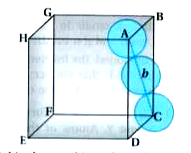Complete Solutions to SECTION - A (QUESTIONS) of chapter THE SOLID STATE of Class 12 book with complete answers and questions
| Class 12 | CHEMISTRY |
| Chapter | THE SOLID STATE |
| KUMAR PRAKASHAN | SECTION - A (QUESTIONS) |
| Number Of Questions | 60 |
| Academic Year | 2023-24 |
Why liquids and gases are called fluids while solids are rigid ?
View SolutionOn what factors do the stability of the state of matter depends upon ?
View SolutionEnlist the characteristic properties of solid state.
View SolutionExplain crystalline and amorphous solids.
View SolutionDifferentiate Crystalline solids and Amorphous solids.
View SolutionWhat is anisotropy ? Explain.
View SolutionGive classification of crystalline solids.
View SolutionWrite a note on ionic solids or electrovalent solids. State its properties.
View SolutionWhat are covalent solids ? Give example and state its properties.
View SolutionExplain why graphite is good conductor of electricity ?
View SolutionWhat are molecular solids ? State its types.
View SolutionExplain types of molecular solids.
View SolutionWrite a note on metallic solids.
View SolutionWhat is crystal lattice ? How it is formed ?
View SolutionEnlist the characteristics of crystal lattice.
View SolutionWhat are unit cells ? State its types.
View SolutionEnlist the characteristics of unit cell.
View SolutionExplain different types of unit cells.
View SolutionExplain how each sphere (particles) contributes in formation of particular unit cell.
View SolutionCalculate the number of atoms per unit cell in primitive, body centred and face centred cubi unit cells.
View SolutionExplain close packing in one dimension.
View SolutionExplain close packing in two dimensions.
View SolutionExplain three dimensional close packing from two dimensional square close-packing.
View SolutionHow the primitive cubic unit cell is obtained ?
View SolutionExplain three dimensional close packing from two dimensional hexagonal close packing.
View SolutionExplain formation of face centred cubic unit cell and hexagonal close packing in three dimensions.
View SolutionWrite a note on interstitials
View SolutionWrite a note on Voids.
View SolutionHow the formula of a compound can be known on the basis of voids filled in a lattice structure ?
View SolutionExplain how the voids can be located in a crystal lattice ?
View SolutionWhat is packing efficiency ?
View SolutionCalculate packing efficiency in HCP and CCP structures.

View SolutionCalculate packing efficiency in body-centred cubic structure.
View SolutionCalculate the packing efficiency in simple cubic unit cell.

View SolutionHow the density of an unit cell is calculated ?
View SolutionDerive the expression to calculate density of unit cell.
View SolutionWhat are imperfections or defects in solids ?
View SolutionWhat are atomic defects ? State its types.
View SolutionWhat are point defects and stoichiometric defects?
View SolutionExplain vacancy and interstitial defects.
View SolutionExplain stoichiometric defects shown by non ionic solids.
View SolutionExplain Schottky defect and Frenkel defect.
View SolutionExplain stoichiometric defects shown by ionic solids.
View SolutionWrite a short note on non-stoichiometric defects.
View SolutionExplain metal excess defects.
View SolutionExplain metal deficiency defects.
View SolutionExplain defects caused by impurity in ionic solids.
View SolutionClassify solids on basis of electrical conductivities.
View SolutionExplain conduction of electricity in metals.
View SolutionWhat are intrinsic semiconductors ?
View SolutionWhat are extrinsic semiconductors ?
View SolutionExplain doping.
View SolutionExplain n-type and p-type semiconductors.
View SolutionGive applications of n-type and p-type semiconductors.
View SolutionExplain the cause of magnetism in a substance.
View SolutionExplain origin of magnetic properties in a substance.
View SolutionExplain paramagnetism and diamagnetism.
View SolutionWrite a note on Ferromagnetism.
View SolutionExplain antiferromagnetism.
View SolutionExplain Ferrimagnetism.
View Solution
SECTION - A (QUESTIONS) questions and complete solutions for chapter THE SOLID STATE of KUMAR PRAKASHAN KENDRA CHEMISTRY (GUJRATI ENGLISH) of Class 12
All Exercises from KUMAR PRAKASHAN Class 12 CHEMISTRY THE SOLID STATE
- SECTION - A (EXAMPLES)
- SECTION - A (QUESTIONS)
- SECTION - A (TRY YOURSELF)
- SECTION - B (INTEXT QUESTIONS AND ANSWERS)
- SECTION - C (TEXTUAL EXERCISE)
- SECTION - D (NCERT EXEMPLAR SOLUTION)(ASSERTION AND REASON TYPE)
- SECTION - D (NCERT EXEMPLAR SOLUTION)(LONG ANSWER TYPE QUESTIONS)
- SECTION - D (NCERT EXEMPLAR SOLUTION)(MULTIPLE CHOICE QUESTIONS)
- SECTION - D (NCERT EXEMPLAR SOLUTION)(MULTIPLE CHOICE QUESTIONS- MORE THAN ONE OPTIONS)
- SECTION - D (NCERT EXEMPLAR SOLUTION)(SHORT ANSWER TYPE QUESTIONS)
- SECTION - E (MULTIPLE CHOICE QUESTIONS)(DARPAN.S EXAM ORIENTED MCQS)
- SECTION - E (MULTIPLE CHOICE QUESTIONS)(MCQs ASKED IN BOARD EXAMS)
- SECTION - E (MULTIPLE CHOICE QUESTIONS)(MCQs ASKED IN JEE/NEET/AIIMS)